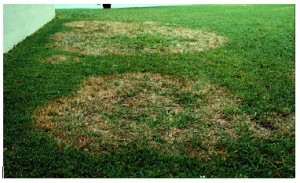One of the most common questions we have been hearing the last few weeks is, “Why does my lawn look so terrible, and how are you planning on fixing it?” As much as those of us in the lawn maintenance industry like to feel in control of your lawn, the reality is, there are some things we can do very little about.

Summer Fungi
During the month of July, most of the country experienced some of the highest sustained temperatures we have seen in many years. This intense, prolonged heat with no rain caused our beautiful green lawns to exhibit signs of drought stress. Even with continued watering from irrigation systems, the heat was far too strong to prevent it. The period of high heat was followed by high humidity and nighttime rain, which set up the perfect conditions for summer fungi, the most common ones being leaf spot, pythium blight, and mushrooms.
In our blog from June 28, 2011, we discussed spring and early summer fungi. Mid and late summer have fungi all there own. According to Wikipedia, there are 100,000 formally described species of fungi, but it is estimated that there are over 5 million species. Fortunately for us, the ones that come to visit us can be eradicated, even if only temporarily.
Summertime brings gray leaf spot. Although it is from the same family as the spring variety and looks very similar when it first appears, it will eventually cause the grass blades to curl and twist. Young grass is the most susceptible, so anything that grew from seed in the spring and early summer is at risk. Pythium blight spreads quickly and can damage a lawn in a matter of days. It behaves very much like snow mold, which we discussed in our blog of March 23, 2011, but it is far more invasive due to the warmer temperatures in which it thrives. And then there are the mushrooms. Spring mushrooms tend to be smaller, dainty and whitish, while summer mushrooms look like alien life forms – large, thick, and in all shapes and colors. They can take over a section of the lawn or a moist garden bed overnight.
Trees are not immune
Our trees are not immune from drought stress, either – many of them began to retreat into survival mode, and we are witnessing the phenomenon known as mid-season leaf drop. Mid-season leaf drop is usually seen on large shade trees. We get a good many phone calls from panicked customers who are concerned that their favorite trees are dying. But leaf drop is a normal process for birch, sycamore and linden trees, and it is caused by the trees’ ability to protect itself from drought. By dropping leaves, the trees lose less water by reducing the leaf surface area, thereby keeping the roots and trunk from dehydration. The health of the tree is generally not affected, and the process allows the tree to survive while it waits patiently for water.
Recovery for your lawn
So how do we ‘fix’ a drought stressed lawn? The answer is, we don’t. Nature does. The lawn must recover on its own. There is no magic potion or perfectly designed lawn application that can make this happen. All we can do as lawn care professionals is focus on stopping the spread of the fungus so that the lawn can begin its recovery. This season is continuing to produce its own set of unique problems in the northeast, since record-breaking rains are helping to restore the health of the grass while also providing the moist, humid environment that fungi thrive in. The excess moisture and humidity make stopping the spread of fungus a difficult task, so very often several applications of fungicide are necessary, applied two weeks apart. And because fungi are produced by spores that can live in the ground for centuries, it makes their complete destruction impossible. The only defense against fungi is to monitor the area often and treat promptly.
Fall Renovation for your lawn
When the types of summer conditions we experienced this year present themselves, a fall lawn renovation is essential to the health of your lawn in order to help it rebuild its strength so it can survive the upcoming winter. Core aeration is good advice and very effective for breaking up damaged root systems and allowing new seed to develop a strong root base. After periods of drought stress, it is customary to apply extra seed to supplement the grass that was lost due to infection. Lawn renovations are done in September – if you are not on your lawn care professional’s list to have it done, we suggest you make that appointment soon. Watering the lawn at the proper times and in the correct amounts after renovation is key. Always water your lawn in the early morning hours, so that the grass and ground have time to dry before the dew falls at the end of the day. Once the new seed is established, reduce watering as the temperatures get cooler. The autumn months generally provide enough rainfall to sustain the lawn.
As always, the lawn care experts at Horizon Landscape Company are always available to answer your questions and help you solve your seasonal turf problems. It is just another way we are helping to Perfect Your Place on Earth.
